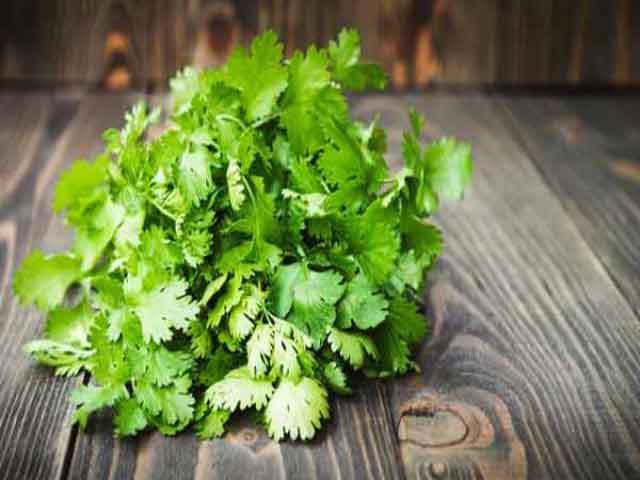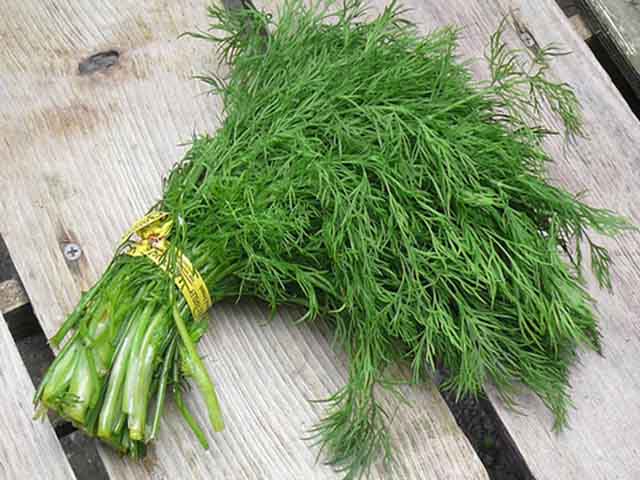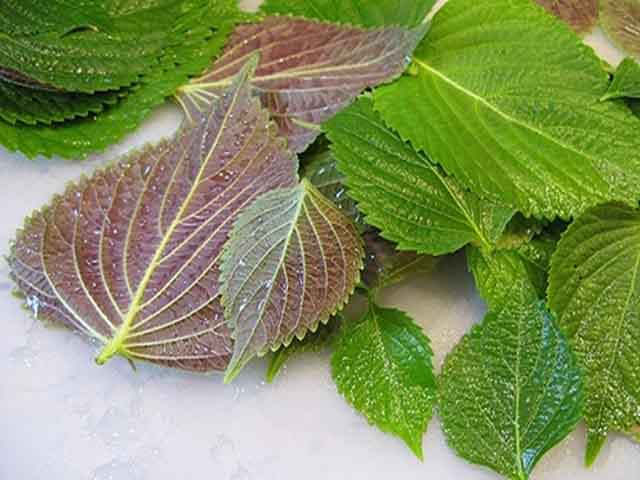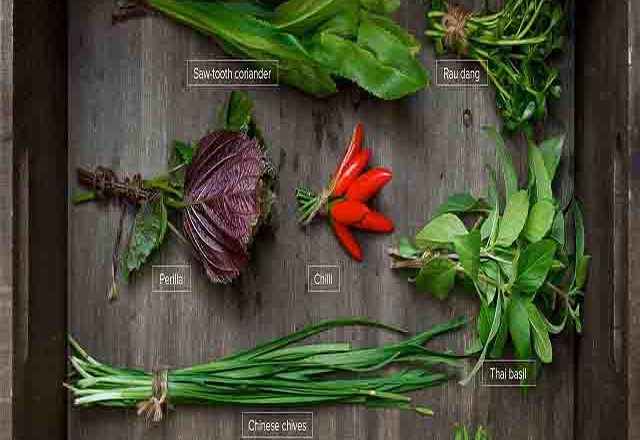Vietnamese spices and herbs are important things when you want to cook the real Vietnamese food. Come to Vietnam, foreign tourists are not only impressed by a small country with shape of S but brave, but also by Vietnamese people’s culture from clothes to behaviors, etc. and especially cuisine of people here. They are surprised by and interested in Vietnamese’s types of food. A simple reason is that Vietnamese dishes’ flavor is different from theirs. The Vietnamese use not only flavors such as salt, sugar, pepper, onion, garlic but use herbs- a plant whose leaves, flowers and seeds are used to flavor food for pleasant smell, for dishes.
There was a French Newspaper “decode” distinctive flavor of Vietnamese dishes. It gave an explanation for why Vietnamese’s dishes were loved by tourists: The other countries usually use spices to cook, but none of country use herbs to flavor for dishes like in Vietnam”.
Herb is one of main spices in Vietnamese food recipes. Besides, herb is also used as green vegetables. It is used with various purposes such as decorating food dishes, flavoring for dishes according to taste of everybody… Herb creates special flavor of Vietnam dishes. In other words, when processing delicious food, we need to combine in harmony with nutrition and many types of spice as well as types of herb in order to make tasty dishes to meet demand of cuisine and protect body from common diseases.
Compare to other vegetables, number of herbs used in cooking is less, but its nutritious value is very high. Moreover, herb helps to balance body in traditional medicine.
Herb is easy to plant and about a few months if weather is favorable. And then, we can have fresh and safe herb to use. There are many famous villages where plant herbs such as Lang Village (Ancient Hanoi), Tra Que Village (Quang Nam), etc.
Let Adventures Travel Vietnam show you 5 main types of herbs used popularly and regularly at Vietnamese families:
Coriander (Rau Mùi) – Most Important Herb To Cook Daily Vietnamse Food
Coriander is one of the most commonly used herbs – in spite of the fact that the name comes from the Greek, meaning bed bug! It is green, leafy and strong-smelling with a fresh, citrus taste that makes it an invaluable garnish and flavor enhancer. Coriander’s leaves are long, but its stems are knotty and knobby. Also known as Laksa leaf, Vietnamese coriander is also more fragrant than Culantro. Both the fresh leaves and stalks are edible, as well as the berries, which are dried and called coriander seeds. Although sometimes eaten alone, the seeds often are used as a spice or an added ingredient in other foods.
For some dishes, its leaves are used as a spice and its dried greed is grilled and scattered over dishes. For maximum flavor, it is best added to dishes just before serving. Because of coriander’s flavor, it is used in many delicious dishes such as beef wine sauce, taro ribs soup or in attractive salad dishes.

Vietnamese coriander – Necessary Spice to Cook Vietnamese Food
Culantro (Mùi Tàu) – Indispensable Herb To Cook The Noodle Soup Pho
Culantro is actually the Spanish nam of an herb in the parsley family that bears the specific name Eryngium Foetidum and has long leaves edges with spines. In Vietnam, it is known as thorny coriander. Culantro has a similar smell and taste to coriander. However, coriander’s flavor is stronger than Culantro’s.
Culantro is popularly used in making a bowl of Pho. In other words, Culantro is an optional garnish in Vietnamese Pho, along with the bean sprouts, lime wedges, chopped Asian chili and Thai basil. When tourists eat a bowl of Pho, it is up to them to put culantro in their bowl or not.
Many people just tear the long culantro leaves into pieces of about 1 to 2 inches long and drop them directly into their bowl before taking the first bite. Many Pho connoisseurs like to tear culantro into smaller pieces and add them as they eat their Pho.
Thanks to adding culantro into Pho, a bowl of Pho looks more attractive and delicious. Many foreign tourists to Hanoi cannot forget Hanoi Pho’s flavor.

Vietnamese Culantro – Popular herb to cook the noodle soup Pho
Lemongrass (Cây Xả) – Asian Taste Spice In Vietnamese Cuisine
Lemongrass is native to India and tropical Asia. It is a stalk plant. It widely used as an herb in Asia cuisine in general and Vietnam cuisine in particular. It has a subtle citrus flavor and can be dried and powered or used fresh. It’s also suitable for using with poultry, fish, beef and seafood.
Lemongrass is cut into slices or short segments and used in chicken stirring with lemongrass, curry dishes, etc. Especially, it flavors main fragrant for Bun Bo Hue with mixture of hot, acid, salty and sweet spices.

Vietnamese lemongrass offers the mixed taste of hot, acid, salty and sweet spices
Dill (Thi Là) – Important Vietnamese Spice For Fish Dishes
Dill is a common herb that is quite easy for the average gardener to grow. The fresh leaves, flower heads and dill seeds are used for cooking and herbal remedies. People may know that dill is used to flavor pickle, but it has many other uses as well.
Dill is mainly used in cooking fish dishes. We can use fresh dill in marinating fish, or lay sprigs of fresh dill on fish when we are baking or poaching it. Chopped fresh dill can be added to sauces for fish.
In addition, we also can it to make tasty salads. For example, hot cabbage salad we make by adding a tablespoon of chopped fresh dill leaves to our favorite hot cabbage salad recipe.

Dill – a common herb in Vietnamese cuisine.
Vietnamese Palm (Rau Kinh Giới) – Efficient Fresh Herb For Salads
Vietnamese palm bring a mixture of lemongrass, Thai basil and mint. Its leaves are short with spine edge.
Unlike drill, lemongrass used for cooking, Vietnamese palm is usually used in salads such as banana flower salad or eaten as a type of fresh vegetable with Bun dau, Bun cha, etc.
If Vietnamese’s dishes are lack of these types of herb, they will be less tasty and attractive. Therefore, using herbs in Vietnamese’s meals is common and necessary.
Besides enhancing flavor for dishes, herbs are also known as one of important folk medicines to treat diseases.

Vietnamese palm brings a mixture of lemongrass, Thai basil and mint
There are several Vietnamese spices and herbs to know for a local food lover. Follow other articles on our website to get useful tips on How to cook Vietnamese food!
If you would like to explore and taste various delicious kinds of Hue cuisine, chat with local people, study their livelihoods and understand more Hue History and Culture, Join Hue Street Food Tour from Adventures Travel Vietnam. We guarantee a local perspective that will give you and your family a once in a lifetime experience.

